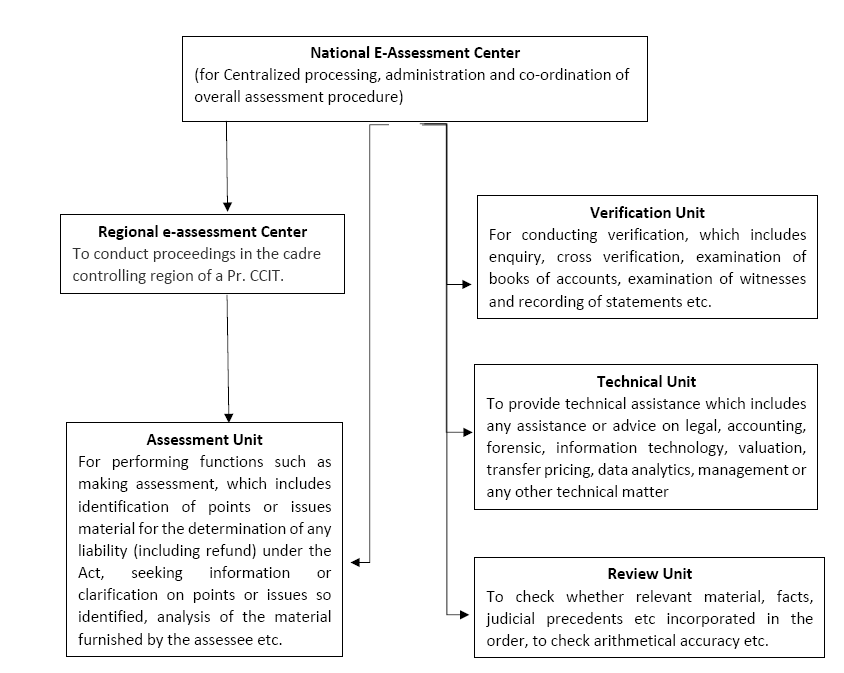
CA Piyush Bafna has explained the nuances of the E-assessment Scheme, 2019. He has opined that the scheme will impart greater transparency and accountability by eliminating the interface between the Assessing Officer and the assessee and by effectively utilizing the resources through team-based assessment. However, he has also pointed that there are several issues that may prove contentious. He has offered suggestions and requested the Government to issue a clarification and streamline the processes
A. Introduction:
Through Finance Act, 2018, Central Government has intended to introduce new scheme of scrutiny assessment under the Income Tax Act, 1961 for improving effectiveness of tax administration. It has thus brought three new sections to the Income Tax Act viz. 143(3A) to prescribe new procedure by the Central Government, 143(3B) to enable Central Government to notify applications of provisions of the Income Tax Act with such modification, adaptions or exceptions as may be specified and 143(3C) to provide for laying every notification issued u/s 143(3A) or 143(3B) before each House of Parliament.
The intention to implement the faceless assessment was again reiterated by Finance Minister while presenting budget on 5th August, 2019.
To effectuate the same, Central Government on 12th September, 2019 brought notification u/s 143(3A) prescribing the procedure for face-less e-assessment called as ‘E-Assessment Scheme, 2019’.
B. New operational set up:
As per E-assessment Scheme, 2019, following Center and Units will be constituted to undertake assessment proceedings –
C. New E-assessment Procedure:
1) A notice u/s 143(2) shall be issued and served by National e-Assessment Center.
2) Assessee has to file reply within 15 days.
3) The case selected for scrutiny will be assigned to specific assessment unit or one of Regional e-assessment Center.
4) On request of Assessment Unit, National e-assessment Center may issue notice for obtaining information, documents or evidence from assessee.
5) If Assessment Unit request for conducting inquiries or for seeking technical assistance, National e-assessment Center shall assign said request to the Verification Unit or Technical Unit respectively.
6) the assessment unit shall, after taking into account all the relevant material available on the record, make a draft assessment order in writing either accepting the returned income of the assessee or modifying the returned income of the assessee along with details of penalty proceedings to be initiated, if any and send a copy of such order to the National e-assessment Centre.
7) The National e-assessment Centre then will examine the draft assessment order in accordance with the risk management strategy specified by the Board to decide to –
(a) Finalise the assessment as per the draft assessment order and serve a copy of such order and notice for initiating penalty proceedings, if any, to the assessee, along with the demand notice or refund due or
(b) In case a modification is proposed in the draft order, it will provide an opportunity to the assessee by serving a notice calling upon him to show cause as to why the assessment should not be completed as per the draft assessment order; or
8) In case modification is proposed, National e-assessment Center will issue show cause notice to the assessee. If assessee fails to furnish reply, assessment will be finalized as per draft assessment order whereas if reply is received, same will be forwarded to Assessment Unit.
9) In case National e-assessment Center assigns the draft assessment order to a Review Unit in any one Regional e-assessment Centre, through an automated allocation system, for conducting review of such order, Review Unit may concur with the draft assessment order or suggest any modification as it may deem fit.
10) In case Review Unit concur with draft assessment order, National e-assessment Center will finalize assessment as per point No. 7 whereas in case Review Unit suggests modifications, it will communicate the same to the Assessment Unit.
11) Assessment unit after considering the modifications suggested by Review Unit and considering the reply of the assessee in case proposed modifications are prejudicial to the interest of assessee, shall pass revised draft assessment order and send the same to National e-assessment Center.
12) After completion of assessment The National e-assessment Centre shall transfer all the electronic records of the case to the Assessing Officer having jurisdiction over such case., for –
(a) imposition of penalty;
(b) collection and recovery of demand;
(c) rectification of mistake;
(d) giving effect to appellate orders;
(e) submission of remand report, or any other report to be furnished, or any representation to be made, or any record to be produced before the Commissioner (Appeals), Appellate Tribunal or Courts, as the case may be;
(f) proposal seeking sanction for launch of prosecution and filing of complaint before the Court;
13) If considered necessary, National e-Assessment Center at any stage transfer the case to the assessing officer for completing the assessment in face to face mode.
D. Assessments covered:
Since National e-assessment Center can only issue notice u/s 143(2), the assessments initiated by issuing notices under sections other than section 143(2) such as in following cases may not be covered by this scheme –
a) Where reopening of assessment is initiated by issuing notice u/s 148;
b) Assessment is taken up in pursuance of search and seizure u/s 153A or 153C; or
c) In case no return is filed despite having taxable income leading to best judgement assessment u/s 144;
d) Fresh or modified orders for giving effect to the order of appellate authorities.
E. Penalty proceedings:
In case assessee fails to comply with notices issued by any unit, such unit may recommend initiation of penalty proceedings. In such case, National e-assessment Center will issue show cause notice to the assessee and if satisfied may drop the penalty otherwise may levy the penalty by passing order.
F. Appellate proceedings:
The appeal against the order passed by the National e-assessment Unit shall be filed before Commissioner of Income Tax (Appeals) having jurisdiction over jurisdictional assessing officer.
G. Authentication of record:
Each communication issued by the Department has to be authenticated by digital signature whereas communication is by the assessee or other person, it may also be authenticated by electronic verification techniques such as EVC etc.
H. Delivery of Notice:
Every notice or order or communication shall be delivered by way of sending copy to registered account or registered email of assessee or authorized representative or uploading copy on assessee’s mobile app with real time SMS.
I. Use of video conferencing only:
In case any modification is proposed in the draft assessment order after issuing show cause notice, the assessee or his authorized representative can seek personal hearing and, in such case, said hearing shall be exclusively conducted through video conferencing.
It is also clarified that all the statements except statement u/s 133A would be recorded exclusively through video conferencing.
J. Open issues:
Though this scheme is laudable effort taken by the government for hassle free assessment, following aspects needs further clarification or consideration –
1) This Scheme to the extent inconsistent with the provisions of section clause (7A) of section 2, section 92CA, section 120, section 124, section 127, section 129, section 131, section 133, section 133A, section 133C, section 134, section 142, section 142A, section 143, section 144A, section 144BA section 144C and Chapter XXI of the Act, modifies application of these sections in its present form. Since this scheme is brought by way of notification deriving power u/s 143(3A) and 143(3B) by Central Government, its scope as a delegated legislation can be questioned on the grounds of substantive ultra vires and on the ground of the constitutionality of the provisions of the delegated legislation or on the ground of its being unreasonable and arbitrary.
2) In case matter is referred by National E-Assessment Center to Review Unit, it may accept the draft order or it may suggest modification. However, it is not clear whether the modification suggested by the Review Unit is binding on the Assessment Unit or it may take its own view as the words used in the scheme are Assessment unit shall consider and not incorporate the said modifications in the revised draft assessment order.
3) It is not clear as to how the revisionary jurisdiction u/s 263 by the Administrative Commissioner would be exercised? This scheme may result into dilution of provisions of section 263 as substantial application of mind is involved in the entire new process.
4) The E-assessment scheme prescribes forwarding of draft assessment order to National e-assessment Center by Assessment Unit. Since this scheme modifies inter alia section 92CA and section 144C, it is not clear whether the National e-assessment Unit will forward draft assessment order to the assessee giving an option to approach DRP? Presently, it provides no option to the assessee to raise any objection thereon before DRP. This aspect needs clarification.
5) It is also not clear as to how the scope of limited scrutiny will be converted into complete scrutiny during the course of assessment proceedings by taking approval of Commissioner be implemented under new E-assessments regime.
6) How the satisfaction as required u/s 14A, 68 to 69C etc will be recorded? Will it be recorded by Assessment Unit or can also be directed by Review Unit or National E-assessment Center?
7) It is not clear whether Assessment Unit or jurisdictional assessing officer will invoke provisions of General Anti Avoidance Rule.
K. Conclusion:
By bringing E-assessment Scheme, 2019 Government has taken one more step towards ‘minimum government maximum governance’ with optimally using technology for achieving Digital India initiative. It is a great step taken by the Central Government to impart greater transparency and accountability by eliminating the interface between the Assessing Officer and the assessee and by effectively utilizing the resources through introduction of team-based assessment. It may also strengthen the quality as well as uniformity of assessments as specific assessment unit will be handling the cases selected for specific reason for e.g. penny stock cases may be handled by one particular assessment unit. However initial period may seem some transitional issues which hopefully government will solve with further clarification and streamlining the processes.
| Disclaimer: The contents of this document are solely for informational purpose. It does not constitute professional advice or a formal recommendation. While due care has been taken in preparing this document, the existence of mistakes and omissions herein is not ruled out. Neither the author nor itatonline.org and its affiliates accepts any liabilities for any loss or damage of any kind arising out of any inaccurate or incomplete information in this document nor for any actions taken in reliance thereon. No part of this document should be distributed or copied (except for personal, non-commercial use) without express written permission of itatonline.org |

The article is super. However it has touched the subject of MAINTENANCE OF BOOKS OF ACCOUNTS. Even now the books of accounts are not at all called for even in scrutiny
assessments as most of Assessing officers do not know Tally software knowledge. It paved a path to prepare statement of accounts without any books of accounts. This results in not verifying sections 269SS, 269T, 40(a)(3) etc. This aspect may be brought to the knowledge of our Honorable Finance Minister. JOTHI RAMALINGAM CHENNAI, I.T. CONSULTANT since 1970. Mobile 93872789630
Section 120 has not been amended, will this have any impact?